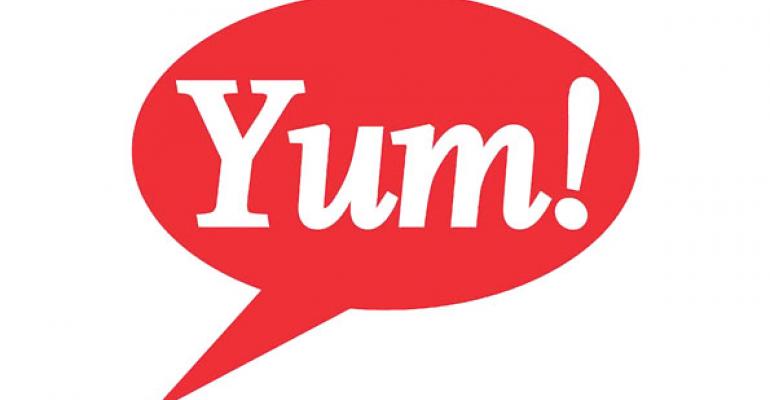Yum Brands Inc. expects its China-division sales to bounce back from a July food-supply scandal that led to a 14 percent drop in third-quarter same-store sales in that region, executives said Wednesday.
“While we’ve done everything we can to turn the situation around, what we need most right now is the gift of time,” said Yum chairman David C. Novak, speaking to analysts in his last quarter as the company’s chief executive before he steps down Jan. 1 to make way for his successor, Taco Bell chief executive Greg Creed.
“Experience tells us it takes six to nine months to fully recover from these types of events, and this will most likely be the case with this situation as well,” said Novak.
The July food-supply scandal “significantly impacted sales at both KFC and Pizza Hut,” Novak said, resulting in the company halving its earnings forecast to six percent to 10 percent from its earlier guidance of a 20 percent increase.
Novak said Louisville, Ky.-based Yum established its earlier guidance on strong results it saw in China, where system sales were growing at about 19 percent with restaurant margins of about 20 percent.
Those trends skidded in the opposite direction after a July 20 televised investigation of Chinese supplier Shanghai Husi, a division of global food supplier OSI, uncovered food-handling problems that “appalled” Yum, Novak said.
“OSI was not a major supplier to YUM and represented only a small percentage of our sales at KFC and Pizza Hut in China. However, given our size and category-leading positions in China, our sales were disproportionally impacted with the same media weight as our major competitor, who was the largest customer of OSI in China.”
Yum terminated its relationship with OSI in China, as well as globally, he said, and tightened the company’s supply-chain standards, instituted a whistle-blower system and installed closed-circuit televisions in production plants.
A 2012 poultry scandal may have deepened the effect of the July reports, Novak said. A December 2012 poultry incident “clearly didn’t help” the company’s image, Novak said.
After that 2012 incident, Yum saw China sales impacted for several quarters amid negative publicity and an official Chinese investigation of Yum’s chicken suppliers. China’s national TV station reported that several poultry farmers, including some that sold chicken to two of Yum China’s suppliers, used an excessive amount of antibiotics on their flocks.
In the most recent case, Novak said he expects the Yum brands to show a strong recovery. Even with the short-term sales declines, the company will continue to invest in new-unit KFC expansion in China, expanding with 700 net new stores in the coming year.
A look forward
(Continued from page 1)
“As we look toward 2015, China is obviously the key variable,” Novak cautioned. “I’m sure you can imagine it’s difficult to predict the exact shape of our bounce-back in sales at this stage of the recovery process.” Novak said YUM continues to market the KFC brand aggressively in China, where it has more than 4,600 units, and is using social-media channels to improve consumer-trust scores.
KFC units now have restaurant margins of about 15 percent on “depressed average unit volumes of $1.4 million,” Novak said. “While these unit economics are strong, this compares to restaurant margins of 20 percent and average unit volumes of $1.7 million in 2011,” he said. “There’s no question in our mind that KFC will get back to these margin levels.”
Novak said the casual-dining-oriented Pizza Hut brand in China will continue to be updated twice a year, with the most recent on Sept. 29, and expand a breakfast option at its more than 1,200 restaurants in 300 Chinese cities. The company plans to open more than 250 Pizza Hut units in the nation this year, he said. “Pizza Hut casual dining is clearly a power brand with a great future,” Novak added.
In China’s Pizza Hut casual-dining division, Novak said the most recent average unit volumes have dipped slightly below $1.6 million and margins to 19 percent. Last year, by comparison, those units had average volumes of more than $1.6 million and restaurant margins “in excess” of 20 percent, he said.
Novak said the company expects to get back to prior levels in both brands.
In July’s incident, Novak said the company responded faster than in the December 2012, especially using the immediacy of social media, and “the sentiment turned around much quicker this time around.”
Novak, who will be visiting Yum’s China team with Creed later this year, said China still offers broad consumer opportunities for Yum’s brands. “The biggest opportunity we have in China is to penetrate the country with new stores,” Novak said.
Yum currently has five restaurants per each million people in China, he said, compared to about 60 restaurants per each million people in the United States.
And China’s market is growing, Novak added. “The consuming class is expected to grow from 300 million people in 2012 to [more than] 600 million people in 2020,” he said, adding that YUM could eventually have 20,000 restaurants across all concepts in China.
Because of that potential, Novak said, “our challenge in China is basically to recover and grow” and Yum will be exercising “every inch of muscle and fiber” to do so.
On Tuesday, Yum reported net income of $404 million for the Sept. 6-ended third quarter, up from $152 million in the prior-year period. Revenue fell 3.2 percent in the quarter, to $3.35 billion, from $3.47 billion in the same period last year. Excluding items that included gains from refranchising and a write-down last year of Yum’s stake in the Chinese restaurant brand Little Sheep, Yum’s per-share earnings in the quarter rose to 87 cents from 85 cents.
Yum has 40,000 restaurants in more than 125 nations and territories. Outside of China, about 90 percent of Yum’s three concepts are franchised.
Contact Ron Ruggless at [email protected]
Follow him on Twitter: @RonRuggless

